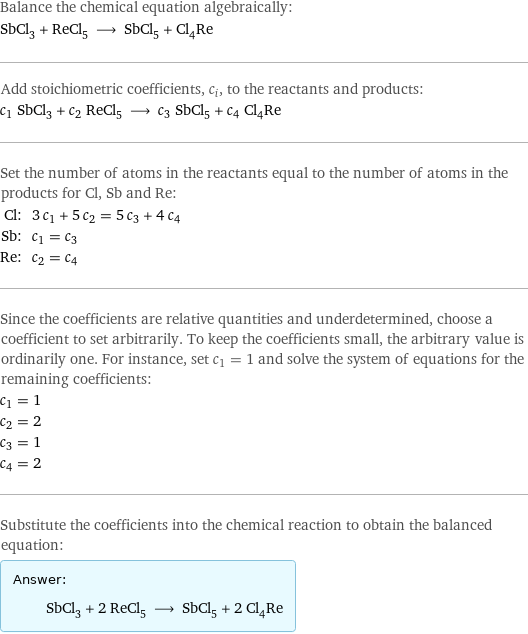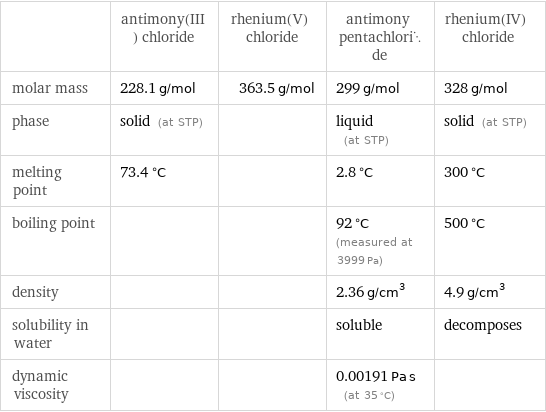Input interpretation

SbCl_3 antimony(III) chloride + ReCl_5 rhenium(V) chloride ⟶ SbCl_5 antimony pentachloride + Cl_4Re rhenium(IV) chloride
Balanced equation

Balance the chemical equation algebraically: SbCl_3 + ReCl_5 ⟶ SbCl_5 + Cl_4Re Add stoichiometric coefficients, c_i, to the reactants and products: c_1 SbCl_3 + c_2 ReCl_5 ⟶ c_3 SbCl_5 + c_4 Cl_4Re Set the number of atoms in the reactants equal to the number of atoms in the products for Cl, Sb and Re: Cl: | 3 c_1 + 5 c_2 = 5 c_3 + 4 c_4 Sb: | c_1 = c_3 Re: | c_2 = c_4 Since the coefficients are relative quantities and underdetermined, choose a coefficient to set arbitrarily. To keep the coefficients small, the arbitrary value is ordinarily one. For instance, set c_1 = 1 and solve the system of equations for the remaining coefficients: c_1 = 1 c_2 = 2 c_3 = 1 c_4 = 2 Substitute the coefficients into the chemical reaction to obtain the balanced equation: Answer: | | SbCl_3 + 2 ReCl_5 ⟶ SbCl_5 + 2 Cl_4Re
Structures

+ ⟶ +
Names

antimony(III) chloride + rhenium(V) chloride ⟶ antimony pentachloride + rhenium(IV) chloride
Equilibrium constant
![Construct the equilibrium constant, K, expression for: SbCl_3 + ReCl_5 ⟶ SbCl_5 + Cl_4Re Plan: • Balance the chemical equation. • Determine the stoichiometric numbers. • Assemble the activity expression for each chemical species. • Use the activity expressions to build the equilibrium constant expression. Write the balanced chemical equation: SbCl_3 + 2 ReCl_5 ⟶ SbCl_5 + 2 Cl_4Re Assign stoichiometric numbers, ν_i, using the stoichiometric coefficients, c_i, from the balanced chemical equation in the following manner: ν_i = -c_i for reactants and ν_i = c_i for products: chemical species | c_i | ν_i SbCl_3 | 1 | -1 ReCl_5 | 2 | -2 SbCl_5 | 1 | 1 Cl_4Re | 2 | 2 Assemble the activity expressions accounting for the state of matter and ν_i: chemical species | c_i | ν_i | activity expression SbCl_3 | 1 | -1 | ([SbCl3])^(-1) ReCl_5 | 2 | -2 | ([ReCl5])^(-2) SbCl_5 | 1 | 1 | [SbCl5] Cl_4Re | 2 | 2 | ([Cl4Re])^2 The equilibrium constant symbol in the concentration basis is: K_c Mulitply the activity expressions to arrive at the K_c expression: Answer: | | K_c = ([SbCl3])^(-1) ([ReCl5])^(-2) [SbCl5] ([Cl4Re])^2 = ([SbCl5] ([Cl4Re])^2)/([SbCl3] ([ReCl5])^2)](../image_source/567069452b2d7bab6112394a04ce3730.png)
Construct the equilibrium constant, K, expression for: SbCl_3 + ReCl_5 ⟶ SbCl_5 + Cl_4Re Plan: • Balance the chemical equation. • Determine the stoichiometric numbers. • Assemble the activity expression for each chemical species. • Use the activity expressions to build the equilibrium constant expression. Write the balanced chemical equation: SbCl_3 + 2 ReCl_5 ⟶ SbCl_5 + 2 Cl_4Re Assign stoichiometric numbers, ν_i, using the stoichiometric coefficients, c_i, from the balanced chemical equation in the following manner: ν_i = -c_i for reactants and ν_i = c_i for products: chemical species | c_i | ν_i SbCl_3 | 1 | -1 ReCl_5 | 2 | -2 SbCl_5 | 1 | 1 Cl_4Re | 2 | 2 Assemble the activity expressions accounting for the state of matter and ν_i: chemical species | c_i | ν_i | activity expression SbCl_3 | 1 | -1 | ([SbCl3])^(-1) ReCl_5 | 2 | -2 | ([ReCl5])^(-2) SbCl_5 | 1 | 1 | [SbCl5] Cl_4Re | 2 | 2 | ([Cl4Re])^2 The equilibrium constant symbol in the concentration basis is: K_c Mulitply the activity expressions to arrive at the K_c expression: Answer: | | K_c = ([SbCl3])^(-1) ([ReCl5])^(-2) [SbCl5] ([Cl4Re])^2 = ([SbCl5] ([Cl4Re])^2)/([SbCl3] ([ReCl5])^2)
Rate of reaction
![Construct the rate of reaction expression for: SbCl_3 + ReCl_5 ⟶ SbCl_5 + Cl_4Re Plan: • Balance the chemical equation. • Determine the stoichiometric numbers. • Assemble the rate term for each chemical species. • Write the rate of reaction expression. Write the balanced chemical equation: SbCl_3 + 2 ReCl_5 ⟶ SbCl_5 + 2 Cl_4Re Assign stoichiometric numbers, ν_i, using the stoichiometric coefficients, c_i, from the balanced chemical equation in the following manner: ν_i = -c_i for reactants and ν_i = c_i for products: chemical species | c_i | ν_i SbCl_3 | 1 | -1 ReCl_5 | 2 | -2 SbCl_5 | 1 | 1 Cl_4Re | 2 | 2 The rate term for each chemical species, B_i, is 1/ν_i(Δ[B_i])/(Δt) where [B_i] is the amount concentration and t is time: chemical species | c_i | ν_i | rate term SbCl_3 | 1 | -1 | -(Δ[SbCl3])/(Δt) ReCl_5 | 2 | -2 | -1/2 (Δ[ReCl5])/(Δt) SbCl_5 | 1 | 1 | (Δ[SbCl5])/(Δt) Cl_4Re | 2 | 2 | 1/2 (Δ[Cl4Re])/(Δt) (for infinitesimal rate of change, replace Δ with d) Set the rate terms equal to each other to arrive at the rate expression: Answer: | | rate = -(Δ[SbCl3])/(Δt) = -1/2 (Δ[ReCl5])/(Δt) = (Δ[SbCl5])/(Δt) = 1/2 (Δ[Cl4Re])/(Δt) (assuming constant volume and no accumulation of intermediates or side products)](../image_source/1be8f8563751d5f5a1f52925d25e5c22.png)
Construct the rate of reaction expression for: SbCl_3 + ReCl_5 ⟶ SbCl_5 + Cl_4Re Plan: • Balance the chemical equation. • Determine the stoichiometric numbers. • Assemble the rate term for each chemical species. • Write the rate of reaction expression. Write the balanced chemical equation: SbCl_3 + 2 ReCl_5 ⟶ SbCl_5 + 2 Cl_4Re Assign stoichiometric numbers, ν_i, using the stoichiometric coefficients, c_i, from the balanced chemical equation in the following manner: ν_i = -c_i for reactants and ν_i = c_i for products: chemical species | c_i | ν_i SbCl_3 | 1 | -1 ReCl_5 | 2 | -2 SbCl_5 | 1 | 1 Cl_4Re | 2 | 2 The rate term for each chemical species, B_i, is 1/ν_i(Δ[B_i])/(Δt) where [B_i] is the amount concentration and t is time: chemical species | c_i | ν_i | rate term SbCl_3 | 1 | -1 | -(Δ[SbCl3])/(Δt) ReCl_5 | 2 | -2 | -1/2 (Δ[ReCl5])/(Δt) SbCl_5 | 1 | 1 | (Δ[SbCl5])/(Δt) Cl_4Re | 2 | 2 | 1/2 (Δ[Cl4Re])/(Δt) (for infinitesimal rate of change, replace Δ with d) Set the rate terms equal to each other to arrive at the rate expression: Answer: | | rate = -(Δ[SbCl3])/(Δt) = -1/2 (Δ[ReCl5])/(Δt) = (Δ[SbCl5])/(Δt) = 1/2 (Δ[Cl4Re])/(Δt) (assuming constant volume and no accumulation of intermediates or side products)
Chemical names and formulas

| antimony(III) chloride | rhenium(V) chloride | antimony pentachloride | rhenium(IV) chloride formula | SbCl_3 | ReCl_5 | SbCl_5 | Cl_4Re Hill formula | Cl_3Sb | Cl_5Re | Cl_5Sb | Cl_4Re name | antimony(III) chloride | rhenium(V) chloride | antimony pentachloride | rhenium(IV) chloride IUPAC name | trichlorostibane | pentachlororhenium | pentachlorostiborane | tetrachlororhenium
Substance properties

| antimony(III) chloride | rhenium(V) chloride | antimony pentachloride | rhenium(IV) chloride molar mass | 228.1 g/mol | 363.5 g/mol | 299 g/mol | 328 g/mol phase | solid (at STP) | | liquid (at STP) | solid (at STP) melting point | 73.4 °C | | 2.8 °C | 300 °C boiling point | | | 92 °C (measured at 3999 Pa) | 500 °C density | | | 2.36 g/cm^3 | 4.9 g/cm^3 solubility in water | | | soluble | decomposes dynamic viscosity | | | 0.00191 Pa s (at 35 °C) |
Units
